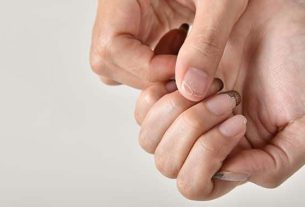Dumbbell exercises, such as bent-over rows, straight flyes and overhead presses, provide many health benefits such as improving fitness and flexibility, helping you lose weight, increasing muscle mass and promoting joint coordination and stability.
Dumbbell exercises are a great option to include in strength training, as they help to work different parts of the body such as the back, shoulders, legs or arms and can be easily done at home, swapping the dumbbells for PET bottles with water or sand, for example.
Before starting exercises with dumbbells, it is advisable to undergo a medical evaluation and have the guidance of a physical education professional, to learn the postures and movements correctly and avoid the risk of injury.
How to do dumbbell training
Dumbbell exercises should be done 2 to 3 times a week, in 2 to 4 sets of 8 to 15 repetitions, depending on the exercise.
Before starting the exercises, it is important to do a general warm-up, and it is a good option to move your arms up and down alternately, and to the sides, several times and at a fast pace. Additionally, to warm up your legs, you can go up and down stairs for 5 minutes, for example.
Some exercise options with dumbbells are:
1. Bent over row (back)
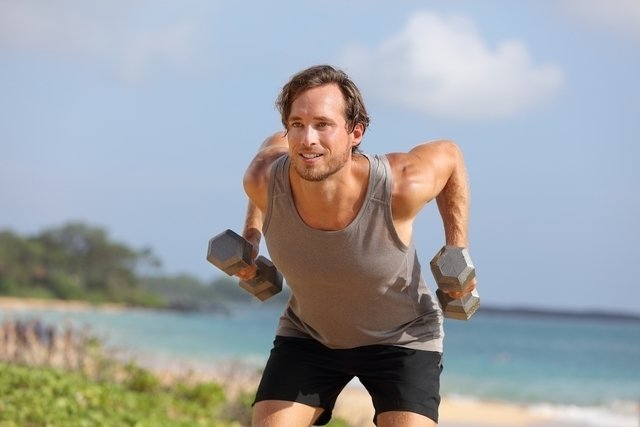
The bent-over row is an excellent exercise option for the back with dumbbells, as it works the upper back muscles, as well as the upper pectorals, deltoids, trapezius and biceps, improving muscular strength and endurance as well as posture. Check out other back exercises that can be done at home.
How to make: Standing, with your legs shoulder-width apart and your legs slightly bent, lean your torso forward. Your arms should be aligned with your body and your hands should be facing inwards, holding a weight in each hand. It is important that your back is straight and your abdomen is contracted.
Pull the dumbbells up, flexing your arms. Slowly lower your arms towards the floor, stretching them completely. With each movement of the arms, you should inhale when the arms are straight and exhale when they are flexed. Do 2 to 3 sets of 12 repetitions and rest 1 minute between sets.
2. Straight fly (chest)
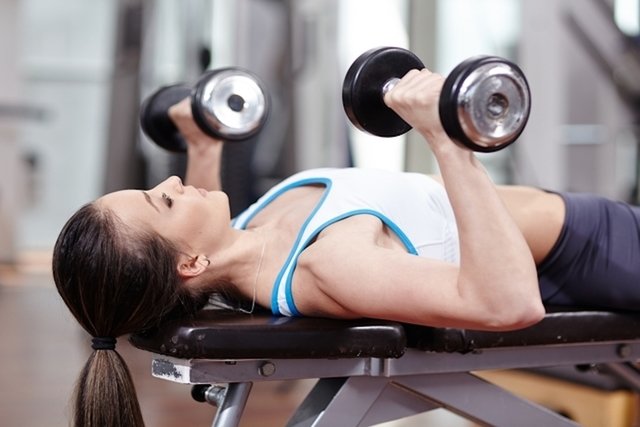
The straight fly is an exercise with dumbbells mainly focused on the chest, but also triceps and deltoids, helping with muscle definition and strengthening, in addition to improving motor coordination. See more exercise options for your chest.
How to make: lie on the floor with your belly up and legs stretched out. With your arms bent at your sides at shoulder height, hold the dumbbells with your palms facing forward. With your abdomen contracted, raise your arms, pushing the dumbbells, turning your hands inward until they are above your chest. Keep your elbows slightly bent and your wrists straight. Lower your arms, always with your elbows bent until they touch the floor.
You can do 3 to 4 sets with a maximum of 15 repetitions and rest for 30 seconds between sets.
3. Lying triceps extension
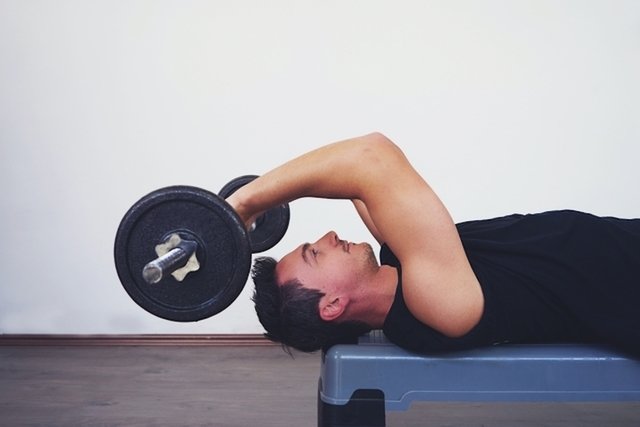
The lying triceps extension is a good exercise option for triceps with dumbbells, as it works strength, resistance, as well as stimulating an increase in muscle mass and volume. See more triceps exercise options that can be done at home.
How to make: Lie on the floor and bend your legs slightly, so that your feet are flat on the floor. Holding a weight in each hand, stretch your arms upwards pointing towards the ceiling. Then, bend your elbows back until your hands with the weights are close to your shoulders, but without moving your elbows. Return to starting position.
Repeat this movement 10 to 12 times doing 2 to 3 sets.
4. Hammer curl (biceps)
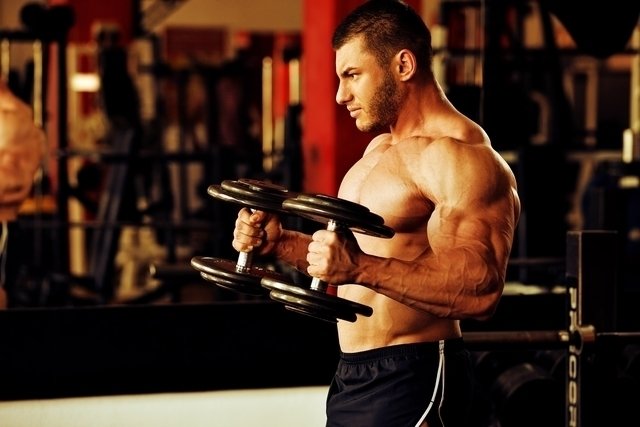
The hammer curl is a very effective dumbbell exercise for increasing the volume of the biceps and brachialis muscle, in addition to working on strength and muscle tone. Check out other examples of biceps exercises to do at home.
How to make: Standing, hold a weight in each hand with the palm facing inward, with the arms down in line with the body. Flex your elbows, raising your forearms until the weights are at shoulder height. It is important to keep your abdomen contracted and not to move your wrists or shoulders to avoid causing injury. Return your arms to the starting position slowly. Inhale when your arms are in the starting position and exhale when flexing your elbows.
You can do 3 to 4 sets of 8 to 12 repetitions each, with 60 to 90 seconds of rest between sets. A variation of this exercise is to raise your arms one at a time in an alternating manner. See other variations of the hammer curl.
5. Development (shoulder)
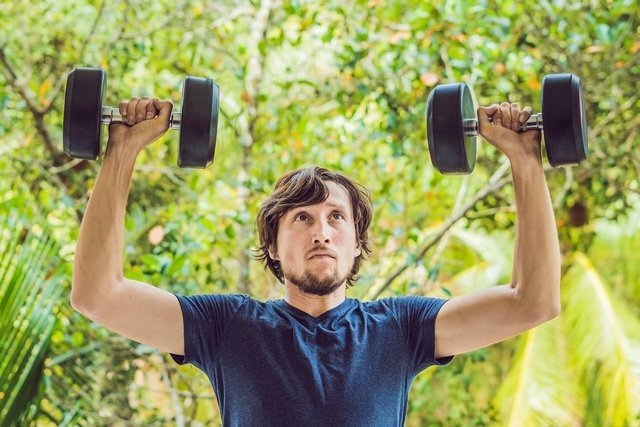
The shoulder development exercise allows you to strengthen and develop the anterior and lateral deltoid muscles, in addition to working the triceps, trapezius and upper pectoral muscles, making it a good option for people who want shoulder hypertrophy. Check out how to do a complete shoulder workout at home.
How to make: Sit on a bench or chair and place the weights so that your upper arm and forearm form a 90-degree angle. It is important that your palms face forward, your back is always straight and your abdomen is contracted. Lift the weights until your arms are straight and return to the starting position.
You can do 2 to 3 sets of 12 to 15 repetitions, with a 30-second break between sets.
6. Dumbbell squats (legs)
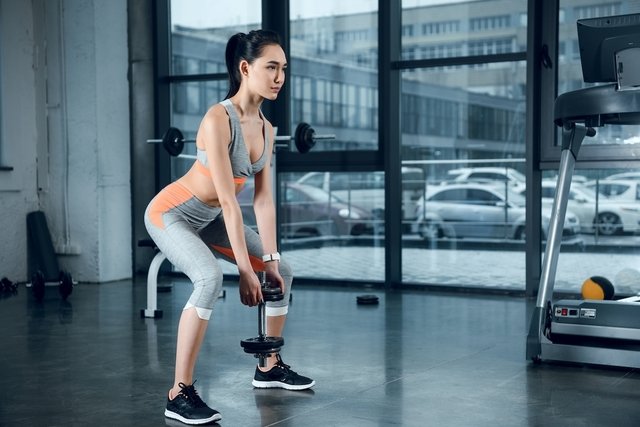
The squat is a complete dumbbell exercise that works the glutes, thighs, calves, back of the legs and abdomen, improving muscle strengthening and stretching, as well as improving the body’s flexibility. See other squat options and how to do them correctly.
How to make: Standing, feet apart, shoulder-width apart. The back should always remain straight and the abdomen contracted. Take the dumbbell with both arms in front of your body and slowly lower yourself, bending your knees, with your arms aligned with your body, leaning your torso slightly forward and pushing your butt far back, as if you were going to sit on an invisible chair. Go down until your knees are at a 90-degree angle and do not extend beyond your toes. Return to starting position.
Do 3 sets of 20 repetitions with 1 minute rest between sets.
What to do after training
After training with dumbbells, you should do stretches to help relax your muscles, tone your muscles, improve flexibility, increase circulation and prevent injuries.
Some examples of stretching to do after exercise are:
1. Stretch your arms back
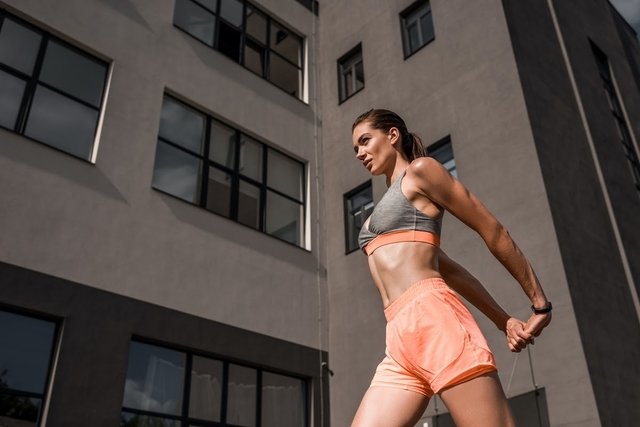
The stretch of stretching your arms backwards should be done standing up to allow for a good stretch of your arms, chest muscles and shoulders.
How to make: Standing, take your arms behind your back until your hands meet. Interlock your fingers and raise your arms, holding for 20 to 30 seconds. It is important to feel that your biceps are stretched, as well as respecting your body’s limits.
2. Hug your legs
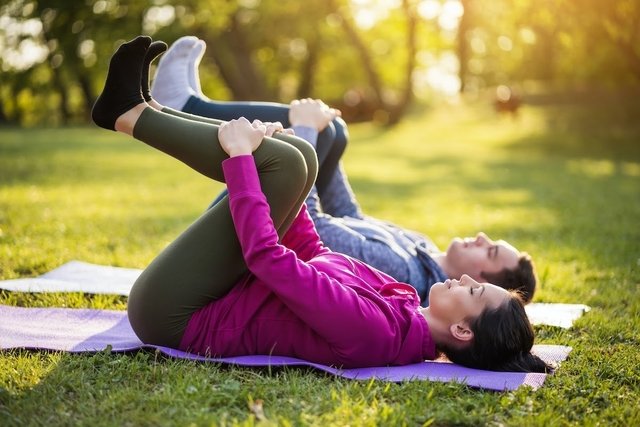
The leg hug should be done lying down, allowing the muscles of the glutes, hips, legs and lower back to stretch.
How to make: Lie on the floor with your stomach up and bend your legs, holding them with your hands for 20 to 30 seconds. Repeat the movement 3 times. Another option is to hug one leg at a time, keeping the other leg straight if possible.

Sign up for our newsletter and stay up to date with exclusive news
that can transform your routine!
Warning: Undefined array key "title" in /home/storelat/public_html/wp-content/plugins/link-whisper-premium/templates/frontend/related-posts.php on line 12
Warning: Undefined array key "title_tag" in /home/storelat/public_html/wp-content/plugins/link-whisper-premium/templates/frontend/related-posts.php on line 13



